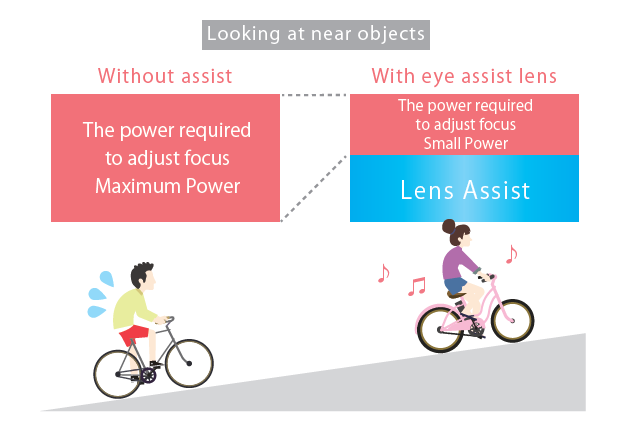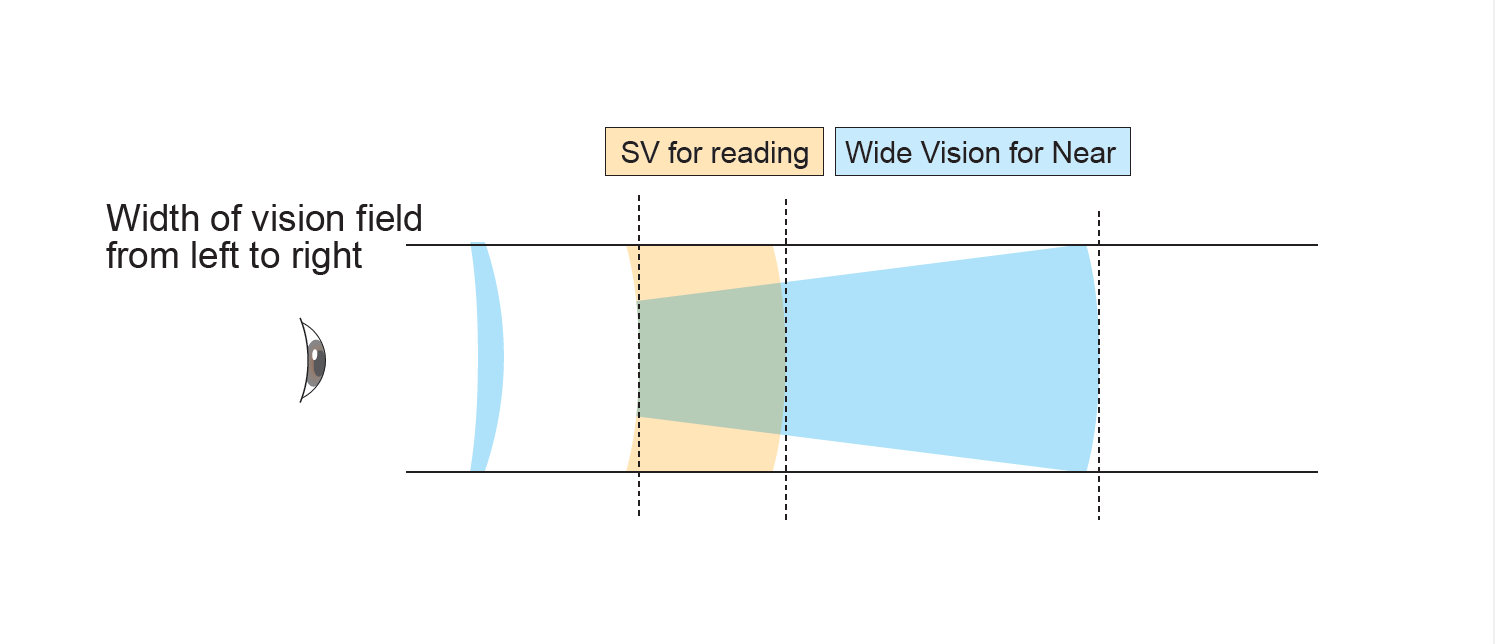In Article(3), we would like to give some advice about the selection of eyeglass lenses for people in their 50s.
For eyeglass lenses suitable for people in their 20s to 40s, see the following:
Eyeglass lenses suitable for smartphones (1) (for people in their 20s, 30s, and early 40s)
Eyeglass lenses suitable for smartphones (2) (for people in their late 40s)
In this article, the key word is the same as the preceding article, “Difficulty of use due to presbyopia anyway.” As you grow older, the distance at which your eyes focus on near objects changes, and so does the usability of your eyeglasses. Let’s think about what eyeglass lenses are good for people in their 50s with this point kept in mind.
○ Recommendations to people in their 50s
For people reaching 50s, living with presbyopia is part of their daily lives. The “limit point at which these people can see near objects” is 67 cm or more in general. While situations where they cannot see near objects increase, many of them may feel less reluctant to use eyeglasses with progressive lenses or reading glasses and deal with such situations appropriately although they feel inconvenient.
For a situation of viewing a smartphone, progressive lenses are the first choice after all, but there are some points that should be taken into consideration.
Point 1: The recommended movement distance of the line of vision (corridor length) is 11 to 13 mm, considering convenience in daily use.

Take a look at the illustration above. It shows the design of a progressive lens.
Combining different levels of power in succession into a single lens causes distortion (dark blue areas in the illustration). These areas not only give the user a strange feeling due to the movement of the line of vision but also make him/her feel uncomfortable with the use of progressive lenses. This phenomenon is unavoidable physically. How these areas should be designed and how discomfort can be reduced are important points for the development and evolution of progressive lenses. This distortion-inducing area tends to become more apparent as the movement distance of the line of vision (corridor length) decreases and the power to adjust focus to near objects (add power) increases. As mentioned in the preceding article, presbyopia progresses exponentially past late 40s, and more “power to adjust focus to near objects” is therefore needed. As a result, many people experience a strong strange feeling or discomfort with lenses having a corridor length of 9 mm like “ClairArte”, which is recommended to people in their late 40s, in conjunction with the short movement distance of the line of vision. On the other hand, people past late 40s become aware of “having presbyopia” more strongly and become less nervous about the reactions of other people. Thus, it can be said that the resistance to the posture of “seeing near objects with the chins up” starts to diminish in this age group.
Considering these facts comprehensively, it is expected that users will desire lenses as shown below:
- I want lenses that make me feel less sway and distortion for daily-use eyeglasses in addition to use for my smartphone.
- I cannot help taking the posture of “raising my chin” to some extent. However, I want to select a smaller, stylish eyeglass frame.
Ideal lenses to meet these desires are those that do not have an excessively long or short corridor length. On the current market, various types of lenses with corridor lengths of 8 to 18 mm are available, and we think lenses with corridor lengths of approximately “11 to 13 mm” are good. Compared to lenses with a short corridor length of, for example, 9 mm, lenses having such corridor lengths cause less sway at the points of the change in power, and offer a wider area for near vision than lenses with a corridor length of 15 mm. Thus, lenses having corridor lengths of 11 to 13 mm also meet the need for “viewing a smartphone.” Furthermore, since the design of an eyeglass frame will not be impaired even if its minimum top-to-bottom width (vertical width of the lens area) is 26 mm when the corridor length is 11 mm, selections of eyeglass frames will not be restricted except in rare cases.
However, eyeglass frames that can be selected depend on the lenses currently used. So, seek in-depth consultation with an eyeglass store. For example, if a user changes his/her lenses with a corridor length of 11 mm to lenses with a corridor length of 13 mm, he/she may experience disadvantage, such as a narrower area for near vision.
Point 2: If you use eyeglasses indoors mainly, we recommend changing the lenses to progressive power lenses for middle/near vision (for indoor use).
The utmost advantage of progressive lenses is “helping the eyes focus on far to near objects with a single lens” and “freeing the user from the nuisance of changing eyeglasses.” On the other hand, their biggest disadvantage is a narrower field of view for each of far vision, middle vision, and near vision than those of dedicated eyeglass lenses. In addition to it, these fields of view become narrower as the “power to adjust focus to near objects” increases due to aging as mentioned earlier. “Changing eyeglasses” or “having multiple eyeglasses” for respective purposes is fundamentally a more desirable approach to living with comfortable vision than using the same eyeglasses with progressive lenses, no matter how expensive they are, in all situations, although the money you can afford to use for them is limited or you may feel changing or having multiple eyeglasses bothersome. The lenses we can recommend to people of this generation based on this concept are “progressive power lenses for middle/near vision.”
For details, click here. → Progressive power lenses for middle/near vision
You can use these progressive power lenses more comfortably in the range from distances to hands to up to approximately 3 meters ahead than progressive lenses, and they are, so to speak, “lenses for indoor use.” Although your eyes cannot adjust focus to far objects, these progressive power lenses ensure a wider field of view for near vision, and above all, offers a much wider middle area (areas in the red circles in the

People probably “view their smartphones” in indoor situations in many cases; for example, in a relaxed time at home, during a break at a company, or on a train or bus on the way to work …
Although it is quite difficult to change eyeglasses on a crowded train, it can be said that the abovementioned situations, in a sense, afford people some space and chance to change eyeglasses. If you feel “a little difficulty in seeing objects with progressive lenses,” we strongly recommend trying progressive power lenses for middle/near vision.





